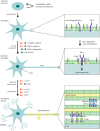Sphingolipids: membrane microdomains in brain development, function and neurological diseases
- PMID: 28566300
- PMCID: PMC5451547
- DOI: 10.1098/rsob.170069
Sphingolipids: membrane microdomains in brain development, function and neurological diseases
Abstract
Sphingolipids are highly enriched in the nervous system where they are pivotal constituents of the plasma membranes and are important for proper brain development and functions. Sphingolipids are not merely structural elements, but are also recognized as regulators of cellular events by their ability to form microdomains in the plasma membrane. The significance of such compartmentalization spans broadly from being involved in differentiation of neurons and synaptic transmission to neuronal-glial interactions and myelin stability. Thus, perturbations of the sphingolipid metabolism can lead to rearrangements in the plasma membrane, which has been linked to the development of various neurological diseases. Studying microdomains and their functions has for a long time been synonymous with studying the role of cholesterol. However, it is becoming increasingly clear that microdomains are very heterogeneous, which among others can be ascribed to the vast number of sphingolipids. In this review, we discuss the importance of microdomains with emphasis on sphingolipids in brain development and function as well as how disruption of the sphingolipid metabolism (and hence microdomains) contributes to the pathogenesis of several neurological diseases.
Keywords: brain; ganglioside; membrane microdomain; neurological disease; raft; sphingolipid.
© 2017 The Authors.
Conflict of interest statement
We declare we have no competing interests.
Figures



References
-
- van Echten-Deckert G, Herget T. 2006. Sphingolipid metabolism in neural cells. Biochim. Biophys. Acta 1758, 1978–1994. (doi:10.1016/j.bbamem.2006.06.009) - DOI - PubMed
-
- Piccinini M, et al. 2010. Deregulated sphingolipid metabolism and membrane organization in neurodegenerative disorders. Mol. Neurobiol. 41, 314–340. (doi:10.1007/s12035-009-8096-6) - DOI - PubMed
-
- Aureli M, Grassi S, Prioni S, Sonnino S, Prinetti A. 2015. Lipid membrane domains in the brain. Biochim. Biophys. Acta 1851, 1006–1016. (doi:10.1016/j.bbalip.2015.02.001) - DOI - PubMed
-
- O'Brien JS, Sampson EL. 1965. Lipid composition of the normal human brain: gray matter, white matter, and myelin. J. Lipid Res. 6, 537–544. - PubMed
-
- Svennerholm L, Vanier MT. 1973. The distribution of lipids in the human nervous system. IV. Fatty acid composition of major sphingolipids of human infant brain. Brain Res. 55, 413–423. (doi:10.1016/0006-8993(73)90306-5) - DOI - PubMed
Publication types
MeSH terms
Substances
LinkOut - more resources
Full Text Sources
Other Literature Sources
Medical
